Thursday from Matthias Hoegg on Vimeo.
Thursday from Matthias Hoegg on Vimeo.
I recently read The Delirious Museum by architect and exhibition designer Calum Storrie. Here's some of my favourite bits. ----
Introduction pg 3: Robert Venuri:
"I am for messy vitality over obvious unity. I include the non-sequitur and proclaim the duality. I am for richness of meaning rather than clarity of meaning; for the implicit function as well as the explicit function. I prefer 'both-and' to 'either-or', black and white, and sometimes gray, to black or white."
----
pg 67: Samson by Chris Burden is a piece of art that pushes apart the gallery it's in as visitors enter through a turnstile.
----
pg 138: This is Gipsoteca Canoviana in Possagno, Italy. A building designed by Carlo Scarpa which houses the working plaster models for sculptures. The space is a very simple cube but has the corners removed and skylights/windows (Scarpa described them as 'fragments of sky') installed instead. I really like this deconstruction/dismantling of the gallery space.
----
pg 151: The Museum of Unlimited Growth was designed by Le Corbusier in 1939. It attempts to solve the problem of a museum building which has an expanding collection (as most museums do). Visitors are directed through a channel in one side and arrive in the centre of the spiral structure from where they can explore the galleries and rooms. The museum can be expanding by adding more spiral over time. I love the idea of a never ending museum- a continuing process. Or even better one which is both complete (it is a complete building) and in process at the same time (it can be added to when needed).
----
Little bit late but here it is. Went to the RCA in short- was surprisingly disappointed with the Interactions work- I think now that most people can use an arduino a bit and appreciate that electronics and stuff isn't as hard as it used to be, the magic has left a bit. I'm not impressed now by a sensor or a projector with a something on it- I've seen it before- quite a bit. It all needs to be coupled with an intelligent and good idea which didn't seem as apparent as in previous years. I was surprisingly pleased with the Product stuff though- don't know why- perhaps because a fair bit of the interactions electronicy stuff has osmosised over- as I said- all that stuff is a lot more accessible than it used to be- the best piece of electronic interaction that was there was in the Design Products space. Whispering Leaves by Ji Long Shon. (and is that Charlotte on her website?)
Earth Coffin by George Fereday looks like what it is- but a good idea mind.
Pressed Chair by Harry Thaler. Not often I like chairs- but this one seems to actually live up to it's eco concepts- I like that if you left it outside it might begin to look like a watering can. I think the raw metal one would look better with age- tricky to do.
Disappearing by Andrew Friend. Read the website and see the pictures. I like this one for a few reasons- the objects look like they are older than they are- the one for the sea looks like a 20 year old buoy. Also the project only comes alive in the photographs- the objects are almost by the by- the photos are the heroes here- contextualising the objects in wall sized photographs at the show was a winner- I've got a real thing at the moment for how far do you need to take a project before it's a project.
 I watched this film over the weekend- not exactly brain food but it's combination of guns, cars, metal and girls led by Jason Statham was exactly what I expected.
I watched this film over the weekend- not exactly brain food but it's combination of guns, cars, metal and girls led by Jason Statham was exactly what I expected.
But one thing I did like was the set up for the film. It provided a background story for how the context of the film came about. They started out with a piece fairly believable information and then started to extrapolate in a fairly logical way to get to an unbelievable conclusion which was then acted out through the rest of the film: Design Fiction. (as I see it) Here's what they said:
. 2012. The United States economy collapses . Unemployment hits a record high . Crime rates spiral out of control. The prison system reaches breaking point . Private corporation now run all correctional facilities for profit . Terminal Island penitentiary streams a series of cage fights live on the internet . Prisoners fight to the death creating a ratings sensation . They are the new Gladiators and Terminal Island is their coliseum . But like the mob of ancient Rome, the modern audience soon becomes bored . They demand more... . Death race is born
Sketch-a-Move from Superflux on Vimeo.
So an amalgamation of things has led to this post- I'm pretty much going to repost stuff that I've collected on my way through the web. This is a google image of Google HQ in California.
First up is a great documentary off of the BBC- The Virtual Revolution: The cost of free. Here's a couple of interesting parts of the film in quote form:
Douglas Rushkoff (Author: Life Inc)
Dr Aleks Krotoski (The shows presenter)
-----
Next is a repost from Ben Terrett of Noisy Decent Graphics blog (also of the RIG) about 'The silver TV steel and glass stand'...
This design kind of sums up everything I hate about bad design in the naughties.
1. It's totally meaningless, devoid of any added value. 2. It's essentially a style that's been ripped off. Hugely derivative of something (probably from Ive) that was once good and then expanded and bastardised to death. 3. It triggers more poor imitations, and leads design buyers to say things like "I want it like they did it". 4. Everyone blindly buys one because everyone else has bought one. No one actually stops to think, do I like this? 5. It's so damn ugly and intrusive. Sat in the corner of your lounge looking shit.
-----
Next is a repost from It's Nice That's 'Discussion' Feature: 'The Blog Blackout' by Chris Gray...
So, where now, how do we stay aware without falling into the pitfalls of styles and trends?
-----
So fill in the gaps yourself, and rant over. Go watch that documentary though- here.
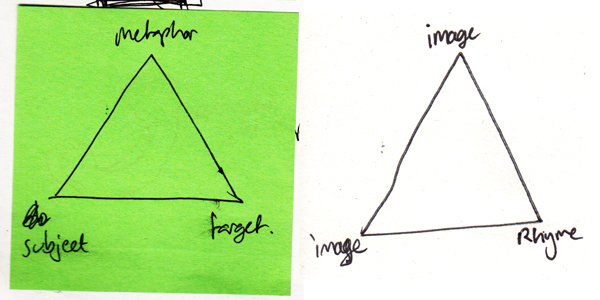 I'm interested in the relationships between objects. For the purposes of this piece of writing, 'objects' will be 2D images or titles/words.
I'm interested in the relationships between objects. For the purposes of this piece of writing, 'objects' will be 2D images or titles/words.
I am interested in the relationships which can be formed between two objects when they are presented side by side- as in a book spread. The spread creates a context for the objects to inhabit and invites the viewer to understand not only two separate images, but also the narrative which the objects create together, through merit of sharing the same space.
There are three ways in which adjacent objects may reference each other.
The first is to do with the physicality of the objects - colour, shape, form - strictly aesthetics. Two images may refer to each through merit of both being blue, or the focal point being a clock etc.
The second is concerned with the symbolical nature of an object and the ideas, attributes, and meanings which such objects reference. For example an image of a beach representing a memory of a holiday, a shell as a souvenir of the same experience, or a train ticket of the journey completed to get to the holiday. Other examples of ideological referencing could be religious symbols, celebrity icons, or brand logos.
The third referencing type is one of labelling and frames. Objects, even if attached arbitrarily, through their nature of sharing a page, refer to each other and have a dialogue. Through merit of being under the same title or being grouped together, these artefacts are forced to begin a discourse with each other. This is known as contiguity- from Aristotle’s ‘Laws of Association’- whereby things which are in close proximity are linked and ‘readily associated’.
Referencing is what allows objects to connect with each other and have a dialogue. Whether this dialogue is interesting or communicates the intentions of the curator depends on how well those objects rhyme together.
The skill of rhyming objects is similar to that of the story teller: to create either an ideological or physical (material or aesthetic) thread between a group of objects to create a fuller, deeper understanding of their context, history, and narrative. Juxtaposition of objects is very important and a pair may still rhyme even if the neighbouring objects are incomplete. Rhyme can give a spread a certain poetic and approximate logic.
I am particularly interested in the accidental ways in which objects may rhyme- when two things are abstracted from their original context and framed as a pair to extract something entirely unexpected and meaningful.
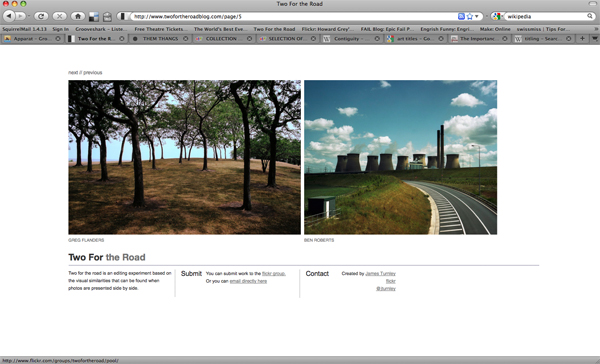
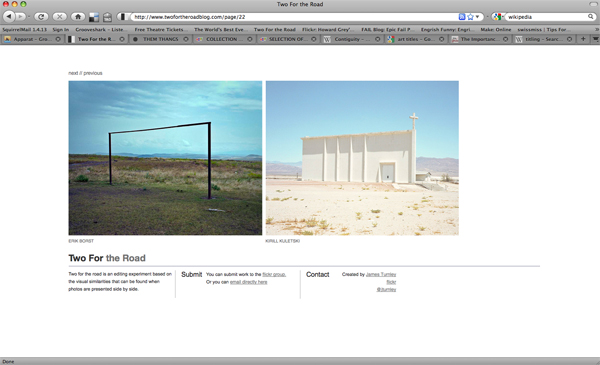 James Turnley created 'Two for the Road' as "an editing experiment based on the visual similarities that can be found when photos are presented side by side." Through merit of proximity the images share a contiguous dialogue. Through this, the image's messages are skewed and a new message emerges. In a similar way that the title of an artwork affects the context it is viewed in, so when objects are put together they cannot help but be changed by each other.
James Turnley created 'Two for the Road' as "an editing experiment based on the visual similarities that can be found when photos are presented side by side." Through merit of proximity the images share a contiguous dialogue. Through this, the image's messages are skewed and a new message emerges. In a similar way that the title of an artwork affects the context it is viewed in, so when objects are put together they cannot help but be changed by each other.
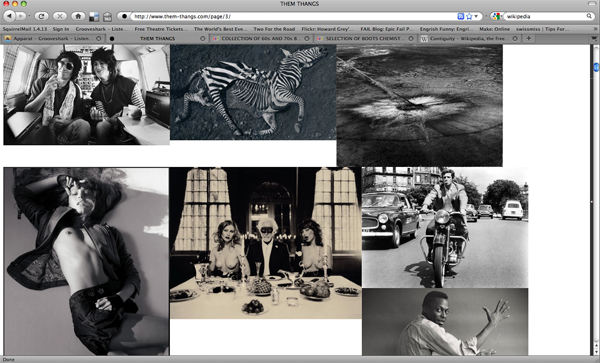
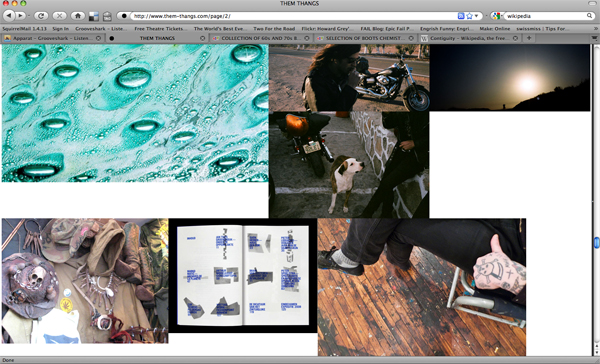 'Two for the Road' is a curated attempt to create rhyme. 'Them Thangs' is run by Justin Blyth: 'It is a collection of things I like, intended for visual inspiration'. It is perhaps best described as a visual blogzine. The display of the images is part curated and part organic. Images are selected but then allowed to flow through the page, creating many and different relationships. Images which ordinarily would seem unremarkable, when viewed as a collection (through benefit of being physically/aesthetically, ideologically or contiguously related) become a necessary part of a captivating and beautiful whole.
'Two for the Road' is a curated attempt to create rhyme. 'Them Thangs' is run by Justin Blyth: 'It is a collection of things I like, intended for visual inspiration'. It is perhaps best described as a visual blogzine. The display of the images is part curated and part organic. Images are selected but then allowed to flow through the page, creating many and different relationships. Images which ordinarily would seem unremarkable, when viewed as a collection (through benefit of being physically/aesthetically, ideologically or contiguously related) become a necessary part of a captivating and beautiful whole.
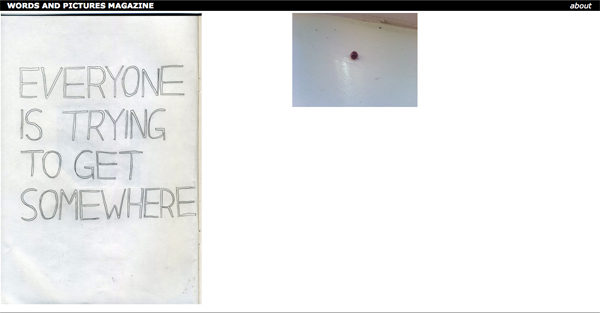
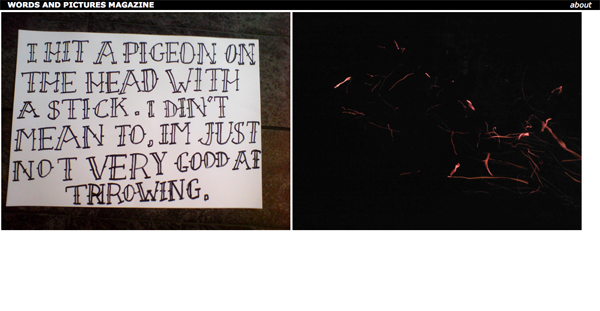
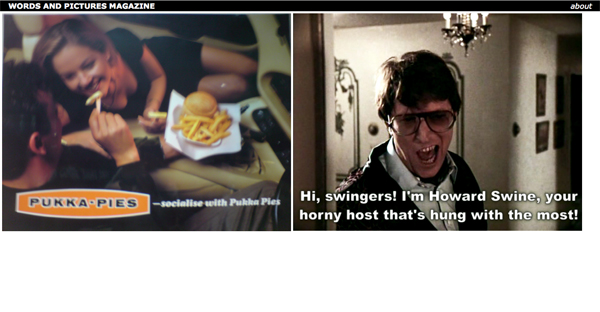 Words and Pictures is a website I am in the process of creating with Mike which attempts to cultivate the moment of rhyme by allowing uploaded content to appear next to each other randomly. This is to further explore the themes discussed here: particularly contiguity, and also to create content for an off line printed magazine of curated and edited pairs of objects.
Words and Pictures is a website I am in the process of creating with Mike which attempts to cultivate the moment of rhyme by allowing uploaded content to appear next to each other randomly. This is to further explore the themes discussed here: particularly contiguity, and also to create content for an off line printed magazine of curated and edited pairs of objects.
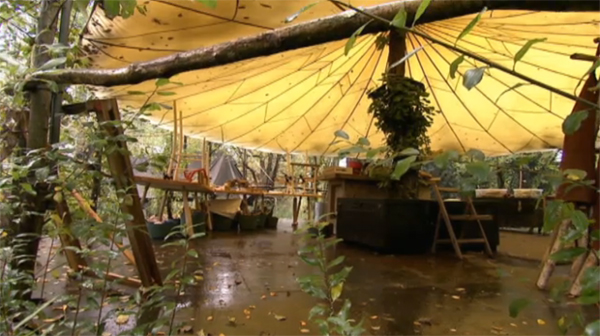
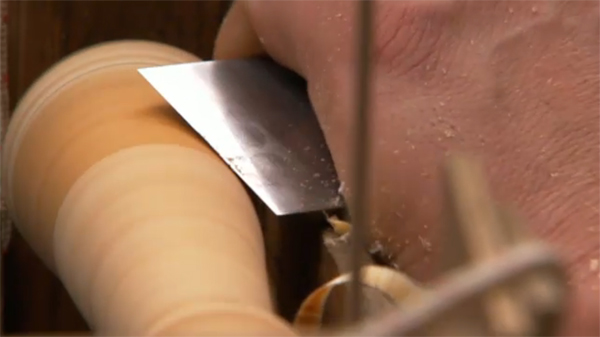
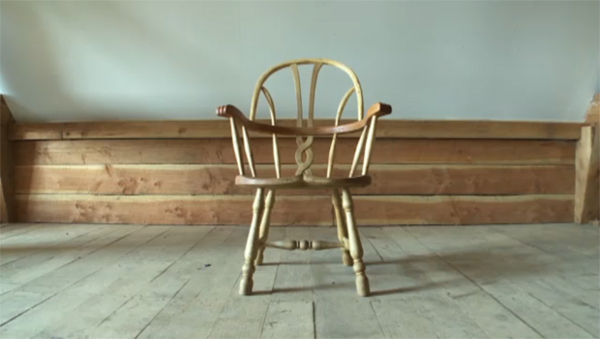 Amazing and inspiring documentary about wood work- really makes you want to run away into a forest and do some bodging. They talk about how in the modern world we are too disconnected from all the material sourcing and making processes and that with creating your own tools and objects (from lathes to kitchen spatulas to decorative chairs) comes a real freedom. The stuff they make is ridiculously strong and durable and when one guy talks about how he's spent 60 hours crafting a chair you get a real idea of the value imbued in that object.
Amazing and inspiring documentary about wood work- really makes you want to run away into a forest and do some bodging. They talk about how in the modern world we are too disconnected from all the material sourcing and making processes and that with creating your own tools and objects (from lathes to kitchen spatulas to decorative chairs) comes a real freedom. The stuff they make is ridiculously strong and durable and when one guy talks about how he's spent 60 hours crafting a chair you get a real idea of the value imbued in that object.
Taking this topic somewhere else: I feel that if more of the stuff and objects we owned were either made by us- or had some kind of time and value invested into them by us, then that would be good thing. Possessions with a narrative attached to them- 'I found this thing here' or 'I restored this' or 'I made this'- seem to be more special and used with a greater joy than some white goods cracked out from China or something. (I think most people have a few things like this- for myself it's the chair that I found in the street, the table I made, the bike my brother restored for me, and the cafetiere that I discovered down Deptford Market.)
I'd like to figure out ways of getting some of the essence of the show mentioned into my life in London. Suggestions very much welcomed.